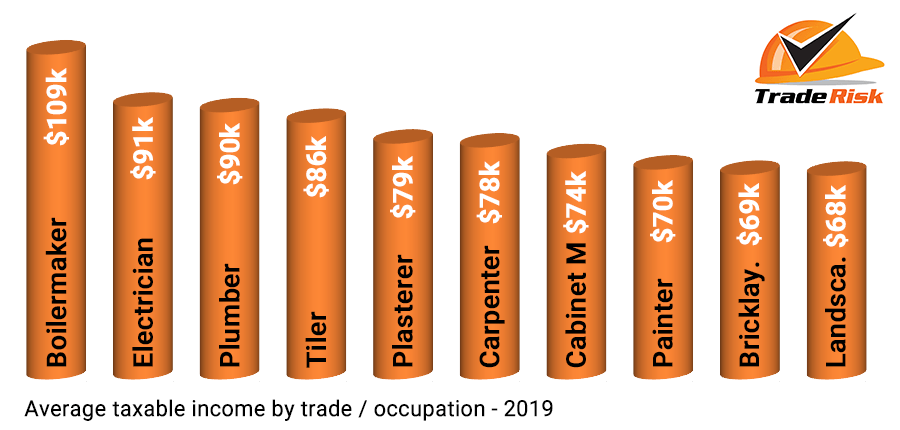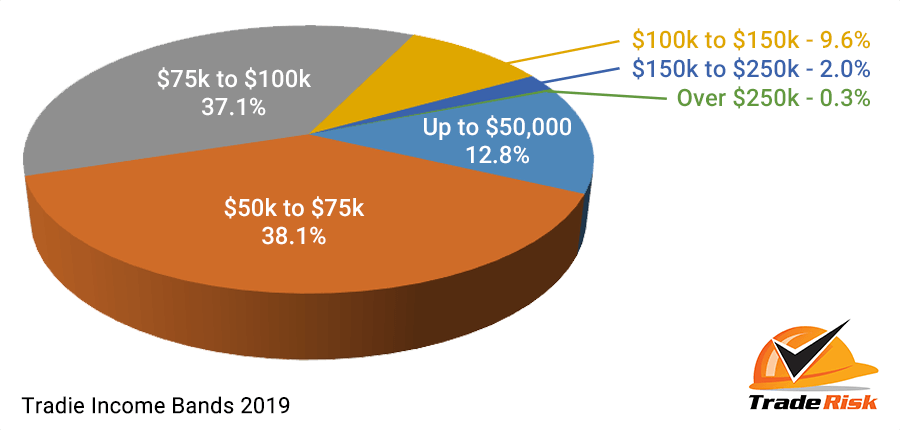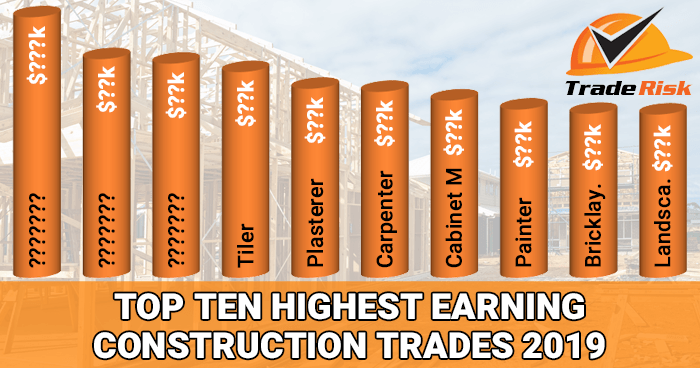This is our 2019 report. To view the current report please click here.
We are pleased to release our 2019 report on that age old question – How much do tradies really earn?
This is our sixth annual report, and also our largest ever, with data coming from almost 1,500 self-employed tradies from around Australia.
It’s important to note that our report focuses on self-employed tradies in the construction industry.
We believe it is the best representation of how much Aussie tradies are really earning, as it utilises the taxable incomes provided to us by thousands of self-employed tradies from around Australia.
We all know that hourly rates have little meaning when it comes to your taxable income. Just because you charge $150 an hour doesn’t mean you can multiply that by 38 hours and get your weekly earnings!
Every year we get loads of feedback about this report. Some people say the figures wrong are way too low, whilst some say they’re way too high. But hey, that’s what an average is right?
For the first time we’ve recorded a podcast episode for our report! Listen below…
The Highest Earning Tradies
Whilst our figures cover a very wide number of trades and occupations, we only detail the top 10 trades that we have sufficient numbers for, in order to remain statistically accurate.
So without further ado, here are the top 10 earning trades for the 2019 financial year:

As with last year the top three on our list were unchanged.
Boilermakers topped the list again, however they did suffer a 6.2% reduction, with an average income of $108,947.
In second place were electricians with an average income of $91,445. This was virtually unchanged from last year, with just a tiny 0.36% drop.

Plumbers rounded our the top three with an average income of $89,568. This was an increase of 3.7% on last year.
Before you say “I know plenty of electricians and plumbers who earn more than $100k”. Yes we know they do, and plenty in our data did too, but these are average figures.
| Rank | Change | Trade | Income | Change |
| 1 | – | Boilermakers | $108,947 | -6.2% |
| 2 | – | Electricians | $91,455 | -0.4% |
| 3 | – | Plumbers | $89,568 | +3.7% |
| 4 | +6 | Tilers | $86,048 | +15.8% |
| 5 | -1 | Plasterers | $79,081 | -5.3% |
| 6 | +2 | Carpenters | $77,772 | +0.5% |
| 7 | – | Cabinetmakers | $74,192 | -6.5% |
| 8 | +1 | Painters | $70,389 | -6.3% |
| 9 | -4 | Bricklayers | $68,634 | -17.7% |
| 10 | -4 | Landscapers | $68,323 | -14.8% |
Tilers were the biggest movers, going from 10th in our 2018 list to 4th in this year’s rankings thanks to a 15.8% increase in average income.
Aside from plumbers and tilers, carpenters were the only others to enjoy an increase, jumping a modest 0.5% to $77,772 and going from 8th to 6th place.
When you have winners there have to be losers… This year it was bricklayers and landscapers , both dropping 4 places each to 9th and 10th positions.
These two trades also suffered the biggest percentage loss, with bricklayers dropping 17.7% to $68,634 and landscapers losing 14.8% to $68,323.
It should be noted that the total number of landscapers on our list was lower this year, and only just above our threshold for statistical accuracy, so we shouldn’t read too much into their numbers.
Also declining were cabinetmakers (-6.5%), painters (-6.3%), boilermakers (-6.2%), plasterers (-5.3%) and electricians (-0.4%).
All of those declining this year, aside from cabinetmakers, enjoyed strong increases last year however, so they’re all still higher than they were in 2017.
Other Trades
As always there were a number of trades and occupations that could have featured in the top ten, however the number of entries were considered too low to be statistically accurate.
We’ve listed them below, but keep in mind that the number of entries for each are very low, so you shouldn’t put too much weight on them.
- Air Conditioning – $106,666
- Flooring Contractor – $100,428
- Joiner – $89,500
- Fencing Contractor – $82,500
- Roofing Contractor – $80,340
- Shopfitter – $78,750
There are a number of others who’s numbers were even smaller and not even worth publishing, but with more entries definitely could have cracked the top ten.
These include refrigeration mechanics, concreters, earthmovers, riggers, scaffolders and stonemasons.
If you’re in one of these trades and want to see yours in the top ten, use Trade Risk for your income protection to help us gather more figures! You’ll be rewarded with award-winning service and advice.
Non-Trades
There are two occupations that could have been included in our list, but they’re not trades as such, so we’ve chosen not to.
But if you’re interested, handymen had an average income of $68,171. This wouldn’t have been enough to crack the top ten, but it wasn’t that far off.
Builders came in at $82,709, but we shouldn’t read too much into that number. Some “builders” are genuine builders, whilst others might be carpenters running smaller projects but still calling themselves builders.
Comparison to the National Average
Our figures show that the average taxable income for a tradie in 2019 is $81,636. This represents a 0.3% reduction on our 2018 figures.
Whilst a 0.3% drop is barely worth mentioning, it would have been nice to see an increase. Australia’s flat wage growth of recent years is well reported however, so it’s no great surprise.
The national average income in Australia, according to the ABS, is $88,140.
That makes our figures for tradies relatively close to the national average across most occupations and business types, but the gap has grown a little since last year.
The closeness still gives us a lot of confidence that our figures are very representative of the true earnings of Aussie tradies.
It’s important to remember that our figures include tradies who are predominantly sole traders and subcontractors, whereas the national average from the ABS will include all sorts of outrageously paid CEOs and executives.
For that reason, just because the tradie average is below the national average, it does not mean that a typical tradie earns less than a typical non-tradie.
Overall income bands
An interesting metric to look at each year is what percentage of tradies fit into the different income bands.

There wasn’t a huge amount of change in terms of the bands where most tradies income fell.
In the up to $50k range, the percentage dropped slightly from 14.7% to 12.8%. This is good news, meaning less tradies were in the lowest income band.
The $50k-$75k range grew from 36.2% to 38.1%. Presumably this increase was a direct result of the lower bands moving up.
The next band up, $75k-$100k, shrunk slightly from 37.1% to 36.1%. The $100k-$150k range declined by a similar amount, dropping from 10.5% to 9.6%.
The $150k-$250k range remained steady at 2.0%, and the $250k+ range dropped ever so slightly from 0.4% to 0.3%.
So what’s the takeout here? There’s not much considering the relatively small changes across the board, but seeing more tradies move out of the sub-$50k range and into the $75k+ ranges is a big positive.
Observations
Each year there are various figures which grab our attention. Here we’ll look at some trends across the last four years of our reports.
Stability at the top
For the third year running we’ve had the same top three earning trades.
Overall there were only three trades which moved up or down by four or more positions, and four trades which remained unchanged.
What’s the reason behind this? It could be that our report is becoming more mature, with more data to make the figures more reliable.
Electricians – declining for the first time
2019 is the first time in our report’s history that electricians have suffered a decline in their average income.
It must be said however that a 0.36% reduction is virtually meaningless, and would be less than the margin for error in a report like this anyway.
Over the previous three years they have risen consistently, by 3.2% in 2018, 4.3% in 2017 and 4.1% in 2016. The slight dip this year is nothing to be concerned about.
You can take a more in-depth look at our ‘how much do electricians earn‘ guide.
Conclusion
If you want to earn more than the national average, each of the top three trades on our list will get you there.
Although the other trades in the top ten have average incomes lower than the national average, it’s important to point out that plenty of those tradies are still doing very well for themselves.
For example although carpenters have an average income lower than the national average, our figures included plenty of chippies with incomes over $100k.
By the same token, the figures also included dozens of electricians and plumbers with income below the national average.
The takeaway here is that although some trades do have higher incomes on average, any tradie can earn a great income if they work hard enough and smart enough.
Want to see the previous reports? Follow the links to our 2018, 2017, 2016 and 2014 reports.
Important information about the figures
When looking at these figures it’s important to get some background on where they’ve come from.
The typical tradesman client of Trade Risk is a subcontractor or sole trader, often working on their own or with just a few staff.
Whilst there will be some clients running large teams and earning very strong six figure incomes, these are not the norm.
We also have clients who are semi-retired or just running their business on the side. To account for this we remove all figures where the declared income is less than $40,000. We’re assuming that anyone with an income below this figure is not running their business in a full-time capacity and shouldn’t be included in our figures.
It’s also important to note that the figures are based on personal income declared for income protection. So the figures are based on profit, not turnover.
Some tradies may say they ‘earn’ $100k, but if their business expenses are $25k a year then the figure we take is $75k.
We don’t claim that our figures are 100% accurate and reflect every tradesman across every industry.
But what we can say is that the figures have come from over 1,000 tradies from all states and territories, and based on previous years they are incredibly consistent and reliable across the years.
If you have any feedback on our report, please get in touch.
Author: Shane Moore. Last updated: 24/10/2019.
What to read next…
Starting an Electrical Business
Switching from Sole Trader to Company
What Insurance does a Contractor Need




